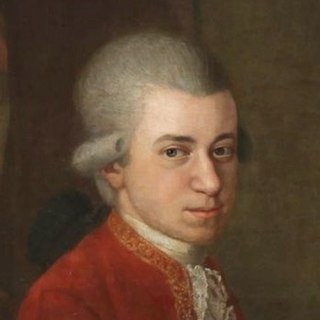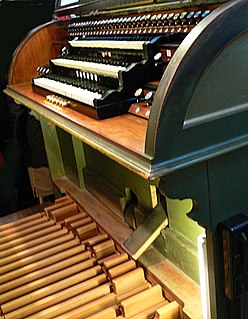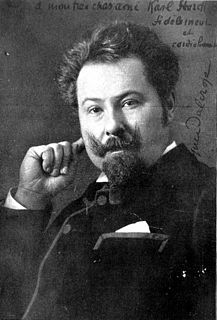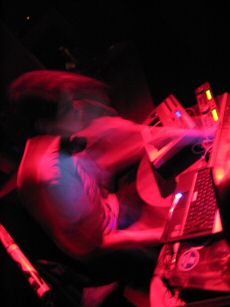
Music is the art of arranging sounds in time to produce a composition through the elements of melody, harmony, rhythm, and timbre. It is one of the universal cultural aspects of all human societies. General definitions of music include common elements such as pitch, rhythm, dynamics, and the sonic qualities of timbre and texture. Different styles or types of music may emphasize, de-emphasize or omit some of these elements. Music is performed with a vast range of instruments and vocal techniques ranging from singing to rapping; there are solely instrumental pieces, solely vocal pieces and pieces that combine singing and instruments. The word derives from Greek μουσική.

MIDI is a technical standard that describes a communications protocol, digital interface, and electrical connectors that connect a wide variety of electronic musical instruments, computers, and related audio devices for playing, editing, and recording music. The specification originates in a paper titled Universal Synthesizer Interface, published by Dave Smith and Chet Wood, then of Sequential Circuits, at the October 1981 Audio Engineering Society conference in New York City.

Music lessons are a type of formal instruction in playing a musical instrument or singing. Typically, a student taking music lessons meets a music teacher for one-on-one training sessions ranging from 30 minutes to one hour in length over a period of weeks or years. Depending on lessons to be taught, students learn different skills relevant to the instruments used. Music teachers also assign technical exercises, musical pieces, and other activities to help the students improve their musical skills. While most music lessons are one-on-one (private), some teachers also teach groups of two to four students, and, for very basic instruction, some instruments are taught in large group lessons, such as piano and acoustic guitar. Since the widespread availability of high speed. low latency Internet, private lessons can also take place through live video chat using webcams, microphones and videotelephony online.

A metronome, from ancient Greek μέτρον and νέμω, is a device that produces an audible click or other sound at a regular interval that can be set by the user, typically in beats per minute (BPM). Metronomes may include synchronized visual motion. Musicians use the device to practise playing to a regular pulse. Many metronomes are now digitized, either in the form of electronic chips instead of mechanics in metronomes, or entirely digital metronomes stored in the cloud or a computer and accessed via a web browser or metronome app.
A music sequencer is a device or application software that can record, edit, or play back music, by handling note and performance information in several forms, typically CV/Gate, MIDI, or Open Sound Control (OSC), and possibly audio and automation data for DAWs and plug-ins.

A composer is a person who writes music, especially classical music in any form, including vocal music, instrumental music, electronic music, and music which combines multiple forms. A composer may create music in any music genre, including, for example, classical music, musical theatre, blues, folk music, jazz, and popular music. Composers often express their works in a written musical score using musical notation.
In music, the dynamics of a piece is the variation in loudness between notes or phrases. Dynamics are indicated by specific musical notation, often in some detail. However, dynamics markings still require interpretation by the performer depending on the musical context: for instance, a piano/p (quiet) marking in one part of a piece might have quite different objective loudness in another piece or even a different section of the same piece. The execution of dynamics also extends beyond loudness to include changes in timbre and sometimes tempo rubato.
Sound design is the art and practice of creating sound tracks for a variety of needs. It involves specifying, acquiring or creating auditory elements using audio production techniques and tools. It is employed in a variety of disciplines including filmmaking, television production, video game development, theatre, sound recording and reproduction, live performance, sound art, post-production, radio and musical instrument development. Sound design commonly involves performing and editing of previously composed or recorded audio, such as sound effects and dialogue for the purposes of the medium, but it can also involve creating sounds from scratch through synthesizers. A sound designer is one who practices sound design.

A MIDI controller is any hardware or software that generates and transmits Musical Instrument Digital Interface (MIDI) data to MIDI-enabled devices, typically to trigger sounds and control parameters of an electronic music performance.
Tempo rubato is a musical term referring to expressive and rhythmic freedom by a slight speeding up and then slowing down of the tempo of a piece at the discretion of the soloist or the conductor. Rubato is an expressive shaping of music that is a part of phrasing.

An expression pedal is an important control found on many musical instruments including organs, electronic keyboards and pedal steel guitar. The musician uses the pedal to control different aspects of the sound, commonly volume. Separate expression pedals can often be added to a guitar amplifier or effects unit and used to control many different aspects of the tone.

New Interfaces for Musical Expression, also known as NIME, is an international conference dedicated to scientific research on the development of new technologies and their role in musical expression and artistic performance.

Émile Jaques-Dalcroze was a Swiss composer, musician, and music educator who developed Dalcroze eurhythmics, an approach to learning and experiencing music through movement. Dalcroze eurhythmics influenced Carl Orff's pedagogy, used in music education throughout the United States.

A wind controller, sometimes referred to as a wind synthesizer, is an electronic wind instrument and usually in the form of a MIDI controller associated with one or more music synthesizers. Wind controllers are most commonly played and fingered like a woodwind instrument, usually the saxophone, with the next most common being brass fingering, particularly the trumpet. Models have been produced that play and finger like other acoustic instruments such as the recorder or the tin whistle. One form of wind controller, the hardware-based variety, uses electronic sensors to convert fingering, breath pressure, bite pressure, finger pressure, and other gesture or action information into control signals that affect musical sounds. Another form of wind controller uses software to convert the acoustic sound of an unmodified acoustic wind instrument directly into Musical Instrument Digital Interface (MIDI) messages. In either case, the control signals or MIDI messages generated by the wind controller are used to control internal or external devices such as analog synthesizers or MIDI-compatible synthesizers, synth modules, softsynths, sequencers, or even non-instruments such as lighting systems.
The Buchla Lightning is the second in a series of MIDI controllers developed by Don Buchla. It consists of two independent hand-held electronic wands and a box unit that enable a player to initiate sounds and to manipulate those sounds spatially.

Live PA is the act of performing live electronic music in settings typically associated with DJing, such as nightclubs, raves, and more recently dance music festivals.

Manfred Edward Clynes was an Austrian-born scientist, inventor, and musician. He is best known for his innovations and discoveries in the interpretation of music, and for his contributions to the study of biological systems and neurophysiology.
Dynamic Tonality is a new paradigm for music which generalizes the special relationship between just intonation and the harmonic series to apply to a wider set of pseudo-just tunings and related pseudo-harmonic timbres.

Piano pedagogy is the study of the teaching of piano playing. Whereas the professional field of music education pertains to the teaching of music in school classrooms or group settings, piano pedagogy focuses on the teaching of musical skills to individual piano students. This is often done via private or semiprivate instructions, commonly referred to as piano lessons. The practitioners of piano pedagogy are called piano pedagogues, or simply, piano teachers.

A Jammerkeyboard is a recently-created type of musical instrument characterized by at least one isomorphic keyboard and thumb-operated and/or motion-sensing expressive controls. The instrument is designed to be easy to learn and to enable the exploration of dynamic tonality.













